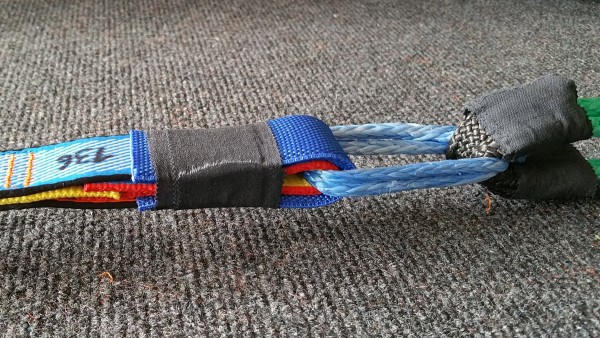Content
1. Introduction
2. Comparison of different slacklines made of polyester and polyamide
3. Comparison between 5mm soft shackle, 6mm soft shackle and 8mm oval quicklink
4. Comparison with attachment on the free shackle side, free shackle side with protective tube and knot side
5. Comparison of different loop lengths and influence of loop protection tube
6. Comparison of different protection tube types
7. Soft Thimble approach
8. Conclusion
1. Introduction
Soft shackles are increasingly used in slackline setups. Especially in modern highline rigging with the split principle, the soft shackles are of vital importance because they connect the highline segments (Inov Split System).
Depending on the rope strength used, soft shackles themselves have very high strengths (5mm approx. 42 kN, 6mm over 70 kN) , very low weight and compact dimensions. The usual method is to connect 2 individual slacklines using their respective sewn end loops with a soft shackle.
What are the breaking loads of the sewn loops when they are attached to a soft shackle? To answer this question, I carried out a small study with 23 breaking load tests. I had to limit myself to one sample per parameter configuration. From a scientific point of view, it is certainly better to make 3 samples per configuration in order to form an average and to be able to make more stable statements. However, I simply lack the resources for a larger study. Therefore, this study is intended to provide first indications of essential relationships.
My study addresses different factors and rigging scenarios which influence the strength retention more or less.
For the majority of my experiments I use a soft shackle made of 5mm Dyneema rope using the "Stronger Soft shackle" knotting method or known as button knot soft shackle. Because of the smaller knot size, 5mm rope seems to me to be more suitable for highline split setups. The strength of the 5mm shackle itself is sufficiently dimensioned at over 42 kN. The base line of my experiments is Aki Polar, a light slackline webbing with a minimum tensile strength (MBS) of 28 kN, an elongation of 4% at 5 kN and extra soft and fine edges. Aki Polar is an ideal webbing for highline split setups. As a standard sewn loop length I use 11 cm with a polyamide protective tube, as I also offer in my shop. I sewed the loops on my Brother BAS311-HN, a state-of-the-art sewing machine with high accuracy and reproducibility. I carried out the breaking load tests on my AkiSnap test system.
2. Comparison of breaking load of different slacklines made of polyester and polyamide
For this comparison, I tested my Aki slackline webbings and the serial sewn loops, each with a length of 11 cm and protective tube, a 5mm button-knot soft shackle (free side) was always used. A Zilla 3 was used on the other side of the slackline. The percentages refer to the MBS of the slackline webbing.


Aki Polar = 21.89 kN / 78% (polyester flat, medium stretch)
Aki White Magic = 25.96 kN / 76% (polyester flat, low stretch)
Aki Voyage / Wizard = 27.64 kN / 83.8% (polyester flat, low stretch, thin)
Aki Sonic II = 30.36 kN / 86.7% (polyamide flat, thick)
Aki Wave 25 = 21.7 kN / 100% (polyamide tubular, thin, broke at sewing)

All loops except for Wave 25 broke at the deflection in the soft shackle. A connection can be seen here that the soft shackle breaking load efficiency of the end loops depends on the slackline material, webbing elongation and webbing thickness, e.g. the ability of the webbing to adapt to a very narrow radius of the soft shackle (this does not mean the rope diameter). Polyamide with high elongation and low webbing thickness has the best break load efficiency. Polyester with less stretch and higher webbing thickness the worst efficiency.
3. Break load comparison between 5mm soft shackle, 6mm soft shackle and 8mm oval quicklink
For this comparison too, all loops (except 3 cm Polar as T-Loop simulation) were made with 11 cm loop length and protective tube.
Aki Polar on 6mm soft shackle = 23.11 kN / 82.5% (5mm soft shackle had 21.89 kN / 78%)
Aki Polar on 8mm quicklink = 25.25 kN / 90.2%
Aki White Magic on 8mm quicklink = 31.86 kN / 93.7% (break on sewing, screw link intact)
Aki Voyage / Wizard on 8mm quicklink = 32.03 kN / 97% (break on sewing, screw link intact)
Aki Polar 3cm loop without protective tube on 8mm quicklink = 22.7 kN / 81%

In summary, it can be seen that an attachment on 8mm quicklinks results in a significantly better use of the strength of the end loops compared to soft shackles. The reason for this is the larger and constant bending radius of the quicklink. Soft shackles already have a V-shape in the final stage before the loop breaks. This is a strong argument against using soft shackles in split setups. A 6mm soft shackle has only minor advantages over a 5mm soft shackle (1,2 kN / 4,5%).
4. Break load comparison with attachment on the free shackle side, free shackle side with protective tube and knot side
Again, use of 11 cm loop length and protective tube on a 5mm button knot soft shackle
Aki Polar sewn loop sits on button knot = 23.79 kN / 85% (free soft shackle side was 21.89 kN / 78%)
Aki Polar sewn loop sits on the free side of the shackle which is covered with a protective tube = 22.57 kN / 80.6%
The positioning of the loop over the soft shackle knot results in a strength gain of approx. 2 kN / 7%. The gain in strength through an additional shackle protection tube is rather marginal (0,7 kN / 2,6%).
5. Break load comparison of different loop lengths and influence of loop protection tube
All tests were carried out with Aki Polar webbing, the loop length was varied. In one test (3 cm) the protective tube of the end loop was omitted to simulate an unprotected simple T-Loop and to have an insight of the effect of a protective tube. For all experiments, the loops were attached on the free side of a 5mm button knot soft shackle.
Reference Aki Polar with 11 cm loop length = 21.89 kN / 78%
Aki Polar with 20 cm loop length = 20.66 kN / 73.7%
Aki Polar with 6 cm loop length = 20.39 kN / 72.8%
Aki Polar with 3 cm loop length = 20.04 kN / 71.6%
Aki Polar with 3 cm loop length without protective tube = 18.79 kN / 67%
In principle, it can be seen that shorter loops have lower breaking loads. This can be justified with the ability of the webbing to compensate for the asymmetrical load distribution across the width with stretch. It is interesting that there is a decrease for longer loops (20 cm), so 11 cm loop length seems to be a sweet spot. This can be examined further.
The use of a protective tube over the sewn loop has a positive effect on the strength. In my example it is about 1.4 kN / 4.5%, so not too big. The quality of this effect is certainly also dependent on the type of protective tube. The thicker and stiffer the protective tube, the better the increase in strength.
6. Strength of different protective tube types
The influence of different protective tube types is examined in this section. Beneath the standard blue polyamide tube allready tested, i have added 32mm wide polyamide (Matrix Outher with 27kN strenght), very thick and dense 25mm wide polyamide (Golden Purple with 32 kN strength) and 20mm wide polyamide (Wave 19 with 16kN strength). All tubes are PU-coated and Purple Gold is very dense and stable. Loop length was 11cm and free side of 5mm soft shackle as usual.

Reference Aki Polar with 27mm blue PA tube (thin, tight)) = 21.89 kN / 78%
Aki Polar with orange 32mm Wave tube (thick, loose) = 21.18 kN / 75.6%
Aki Polar with 25mm Purple Gold tube (thick, very tight) = 22.7 kN / 81%
Aki Polar with 20mm Wave tube (thin, folded) = 21.28 kN / 76%
The results are showing that the strength gain with different tubular material is limited. Its good to have a tight and thick tube, the strength is better here (but i have to say that threading Purple Gold with Polar is more a pain). Thicker loose tube does not improve strength. While on the 20mm tube the webbing was folded in the middle, which might cause some strength reduction on the Polar.
7. Soft Thimble approach
The previous experiments have made it clear that there is a large reduction in breaking strength of conventional sewn loops with protective tube on certain webbings when using a soft shackle. This is all the more noticeable about Aki sewn loops, because thanks to my innovative sewing with Aki Loop Booster they are particularly efficient and are very close to the MBS of the webbing. The average strength of an ALB loop on the Aki Polar is over 27.5 kN, at 28 kN MBS of the webbing, i.e. over 98%. If the loop breaking load is actually only 80%, as is offered by many other slackline companies, the breaking load reduction by a soft shackle is not as noticeable. However, it must be made clear that in this case a system strength of just over 20 kN for a highline does not offer enough safety margin in my point of view. Considering fatigue of the webbing this becomes more worse.
For this reason I have developed a simple solution principle to bring the loop strength back to almost 100% of the MBS range. The so-called Soft Thimble. This is a short piece of Aki Sonic II which is inserted into the end loop and secured with tape or Velcro to prevent it from slipping out to the side.
The following tests demonstrate the effectiveness of breaking load retention. 11 cm long end loops with protective tubing were again tested on the free side of a 5 mm soft shackle.
Aki Polar with simple layer Sonic Thimble insert = 26.74 kN / 95.5% (webbing broke in the Zilla 3 weblock, probably the end loop holds more)
Aki Polar with double layer Sonic Thimble insert = 27.74 kN / 99% (webbing broke at the booster stitching)
Aki White Magic with simple layer Sonic Thimble insert = 32.03 kN / 94.2% (webbing broke at the loop stitching)
It should be considered that attachment of slacklines on soft shackles can result in a high strength loss of the sewn loop (up to approx. 35%). This depends a little bit on the webbing and the sewn loop design. Thick low stretch webbings loose most of the strength. Ask your webbings manufacturer for specific values.
By the use of a Soft Thimble, the strength retention of the sewn loop on a soft shackle can be maximized. It should be mandatory for highline split setups with soft shackles.
Other tests on the same topic were done by "How not to Highline" (but i have to say that i have slightly different results here and using only protective tube is not efficient enough for bringing back full strength on some webbings).



